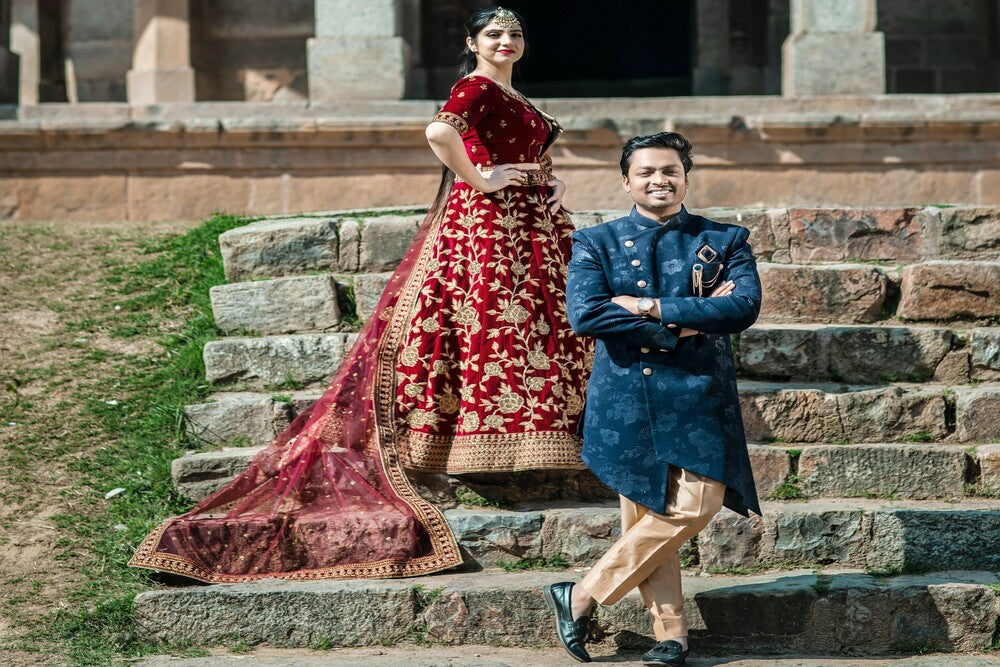
Hinduism is one of the oldest regions in the world and involves a rich tapestry of beliefs, traditions, and cultural practices. In the Hindu faith, clothing is crucial as it reflects their cultural background, personal preferences, and the specific occasion at hand.
Although Hindus do not have a fixed dress code, their attire is deeply connected with social, religious, and ceremonial aspects of life. The Hindu attire entails a fascinating spectrum of styles and symbolism. Here you will learn what Hindus wear and why.
Panaprium is proud to be 100% independent, free of any influence, and not sponsored. We carefully handpick products from brands we trust. Thank you so much for buying something through our link, as we may earn a commission that supports us.
Sari

A sari is a traditional garment for Hindu women in many parts of India and other South Asian countries. It is a long piece of fabric wrapped around the body gracefully and has been worn for centuries. It is an iconic symbol of femininity and grace, representing the region’s rich textile traditions and craftsmanship.
Hindu women usually wear a sari on various occasions, such as weddings, festivals, religious ceremonies, and other events. The sari is known for its elegant and modest appearance. It covers the body fully while allowing for a sense of grace and sophistication. In the Hindu faith, a sari is associated with goddesses, representing devotion, purity, and reverence.
In religious rituals and ceremonies, women may wear a sari as a mark of respect and dedication. Saris come in various patterns, styles, and weaves. In India, wearing a particular type of sari, a woman can showcase her cultural heritage, community affiliation, and social standing. Women pair their saris with a short blouse on top and an underskirt beneath it.
Dhoti

A dhoti is a long rectangular piece of cloth wrapped around the waist and legs in a specific manner. It is a traditional attire for Hindu men and a symbol of masculinity.
They believe that wearing a dhoti connects them to their ancestral traditions and honors the customs passed down through generations. Men wear dhoti during temple visits, prayers, and religious festivals.
The simplicity and purity of the dhoti reflect Hinduism’s spiritual and austere aspects. They add a touch of elegance and formality to the attire, distinguishing the wearer as someone participating in a significant event. The dhoti’s style, color, and fabric vary depending on regional customs and occasion.
Lehenga

A lehenga, or ghagra choli, is a traditional outfit for hindu women. They wear it during festivals like Diwali and Navratri, engagements, weddings, and other celebratory occasions. It consists of a fitted blouse (choli), a long skirt, and a dupatta (stole) draped over the shoulder.
They are elegant traditional attire as the flowing skirt and the form-fitting blouse create a flattering silhouette that enhances the wearer’s beauty. Lehengas are bridal wear, where Hindu brides wear intricately designed lehengas on their wedding day.
These garments are adorned with embellishments, embroidery, and luxurious fabrics. Women wearing lehengas combined with flats stand out in a crowd, exuding a sense of beauty, poise, and traditional charm.
Kurta


A kurta is a traditional tunic-like garment for Hindu men and women. It is a loose-fitting, longer or knee-length shirt with short or long sleeves. Kurtas are available in various designs, from simple and plain to intricately embroidered or embellished.
It is a timeless and versatile outfit for casual gatherings, formal events, temple visits, and other religious ceremonies. The kurta is a symbol of ethnic identity associated with the cultural heritage of India. You can pair a kurta with dhotis, skirts, or matching pants based on your gender and preferences.
Salwar Kameez

The salwar kameez is another attire for Hindu women. It consists of the kameez (tunic or top), the salwar (loose-fitting pants), and the dupatta (stole or scarf).
Women across different regions of India wear salwar kameez to reflect the diversity and richness of Indian heritage. It offers comfort and modesty to Hindu women.
Hindu women wear salwar kameez during religious ceremonies, prayers, and temple visits. They also wear this clothing during weddings, festivals, and other occasions.
Salwar kameez is usually decorated with intricate embroidery, embellishments, or vibrant colors, enhancing its elegance and making it suitable for formal occasions.
Women accessorize it with a dupatta draped over the shoulders for an elegant, festive look. Salwar kameez come in various styles such as Patiala, Anarkali, or straight-cut, allowing Hindu women to express their style and preferences.
Here are some tips on how to look stylish in salwar kameez: 15 best tips.
Sherwani

The sherwani is a traditional Indian outfit for men. It comprises a long coat-like garment, typically longer or knee-length, paired with matching bottoms such as dhoti or churidar pants.
Hindu men wear sherwani with dress shoes when attending special occasions, formal events, and weddings. Hindu grooms often wear a sherwani as their wedding outfit due to its elegance, sophistication, and grace.
The sherwani features intricate patterns, ornate embroidery, and rich fabrics like velvet, brocade, and silk. It may also have embellishments such as beads, zari work, or sequins, enhancing its overall aesthetic appeal.
Bindi

A bindi is an ornamental symbol adorning the forehead, usually positioned at the midpoint between the eyebrows by Hindu women. It manifests as a vivid, vibrant dot or pattern created using vermillion, colored powders, or adhesive stickers.
In most Hindu communities, the bindi indicates a woman’s marital status. Married women often wear a red bindi, symbolizing their marital status and prosperity. Widows and unmarried women opt to adorn a black bindi on their foreheads, while young and unmarried women typically choose a bhindi that harmonizes with the color of their attire.
On special occasions, the customary modest dot of makeup is complemented by a jeweled stick-on mark, adding an extra touch of elegance.
Tilak

A tilak is a forehead mark commonly sported by Hindu men (and occasionally by individuals from other religious communities) and serves as a visible expression of devotion and religious commitment. It represents the “third eye”— a point of inner wisdom and spiritual insight.
Henna body art

Hindus also engage in the tradition of henna body art during festive celebrations. Elaborate patterns are delicately traced onto their hands, arms, and feet using a henna paste and fine brushes or feathers.
After the henna paste is washed off, the intricate design remains as a beautiful network of ochre lines on the skin, serving as a protective barrier against negative energies while inviting good fortune.
See you later, Alvida!
Hindu attire consists of diverse garments with deep cultural, religious, and social significance. Their clothing reflects the rich tapestry of India’s cultural diversity with various styles, fabrics, and designs.
These attires are not just garments; they embody identity, culture, and values passed down through generations. It unites communities, fosters cultural pride, and creates a sense of belonging. Even though many Hindus have embraced Western clothing, these garments remain integral to their lives.
Was this article helpful to you? Please tell us what you liked or didn't like in the comments below.






























0 comments